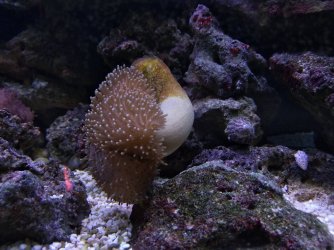I'd be grateful for any ideas on what's going on with this toadstool, and how to fix it?
As you can see its stalk has basically collapsed.
I've fiddled with the flow and I'm gradually increasing the light intensity although AIUI this is a low-light coral.
I wonder if it could be lack of phosphate? My phosphate levels have crashed - full water parameters (as far as I've measured them) are
Ammonia - 0
Nitrite - 0
Nitrate - 5.0
Phosphate - 0
As I don't have any stony corals yet I've only just started testing for calcium, magnesium and alkalinity:
dKH >8.5
Ca >480
Mg >1500
Another thought that occured to me was lack of iodine, but don't yet have a test for that.
TIA

As you can see its stalk has basically collapsed.
I've fiddled with the flow and I'm gradually increasing the light intensity although AIUI this is a low-light coral.
I wonder if it could be lack of phosphate? My phosphate levels have crashed - full water parameters (as far as I've measured them) are
Ammonia - 0
Nitrite - 0
Nitrate - 5.0
Phosphate - 0
As I don't have any stony corals yet I've only just started testing for calcium, magnesium and alkalinity:
dKH >8.5
Ca >480
Mg >1500
Another thought that occured to me was lack of iodine, but don't yet have a test for that.
TIA


